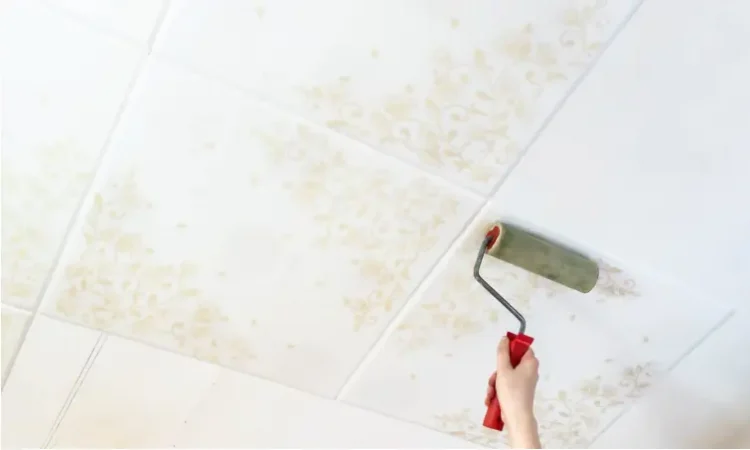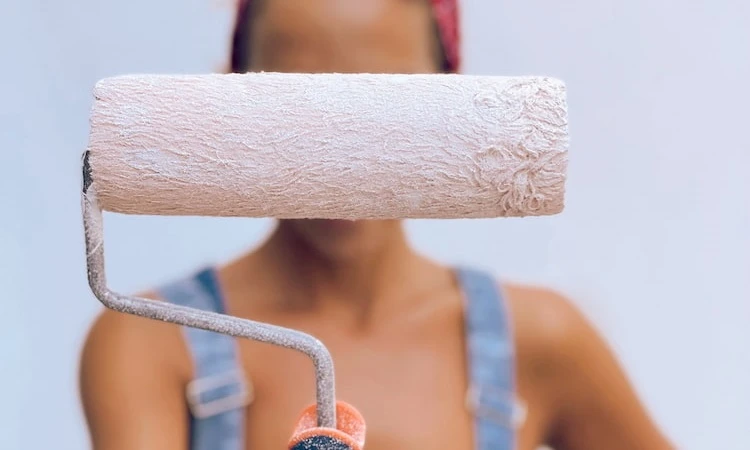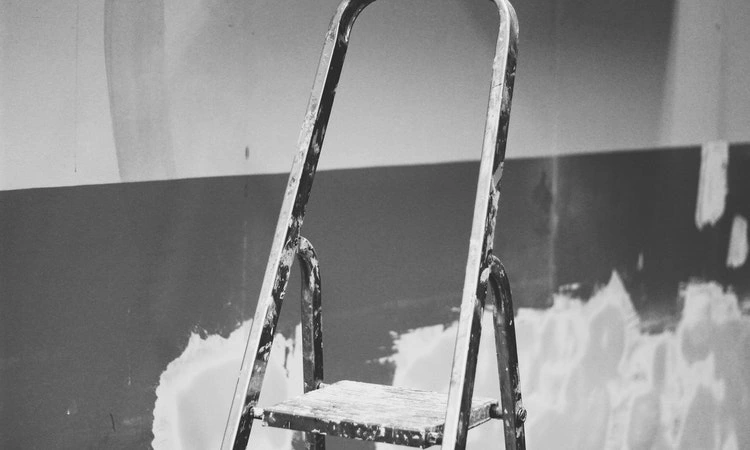Do the ceiling tiles in your office or house look dingy and outdated? You know to repaint your walls frequently.
And now you are probably wondering if you should repaint your ceiling tiles. Is it even possible to paint the ceiling tiles?
Yes, you can paint ceiling tiles. The process will differ slightly depending on what kind of tile you are painting. In general terms, all you have to do is clean, prime, and paint the tiles. Some tiles, such as plastic tiles, will need to be sanded before painting.
The type of paint you use will also depend on the tile you are painting. Latex paints are considered the go-to for painting ceiling tiles.
However, you can use oil-based paints on some tiles. In this article, I will help you learn how to paint acoustical, plastic, tin, and cork ceiling tiles.
I hope you can take this information and turn your ceiling from dingy to welcoming and refreshing.

Is it Safe to Paint Ceiling Tiles?
Many people throughout schools and office buildings paint ceiling tiles. It was reported that a school in Utah had to remove its painted tiles.
The paint is thought to affect the fire retardant abilities of the ceiling tiles. Some tests can determine if the tiles are still fire retardant.
Generally, people state that water-based paints are safer to use on ceiling tiles than oil-based paints.
With that in mind, there is no known health risk with painting ceiling tiles. You paint your walls and furniture, so why not paint your ceiling tiles?
What Kind of Paint Do You Use on Ceiling Tiles?
Interior paint and ceiling paint are very different. Manufacturers made wall paint to be durable and easily cleaned. In contrast, ceiling paint needs to hide irregularities and not draw attention.
For that reason, ceiling paint is thicker than wall paint. Ceiling paint is also only sold in a matte or flat finish.
The dull finish allows ceiling paint to hide imperfections. It also prevents the ceiling from reflecting light and changing the lighting of a room.
Can You Use Exterior Paint on Ceiling Tiles?
Exterior paint is known to be thicker than interior paint. Some people may assume they can use exterior paint on ceiling tiles because it is thick. However, that is not a good idea.
Exterior paint has a higher volatile organic compound (VOC) level than interior paint. High levels of VOCs can be detrimental to your health and the health of others in the room.
If you cannot find specific paint for ceilings, you should use interior paint with a matte or flat finish.
Paint designed for ceilings will be the best paint to use. But I understand that it can be difficult to find ceiling paint sometimes.
In a pinch, you can use interior matte paint on the ceiling. Just make sure you prepare the ceiling so the paint can properly adhere.
How to Paint Ceiling Tiles

The process of painting ceiling tiles will vary slightly depending on which type of tile you are painting.
I will go into detail explaining how to paint each type of tile. But first, I want to talk about the basics of painting any ceiling tiles.
Basics to Know Before Proceeding to Paint
- You will need to lay a tarp down where you will paint. You do not want the paint to drip on the floor or concrete if you are painting outside. Speaking of painting outside, you should always paint outside if possible and feasible.
- All paints contain VOCs, which can be harmful to your health. Even short-term exposure to VOCs can cause dizziness and headaches. If you cannot paint outside, ensure you are in a well-ventilated room. You should also wear a mask while painting indoors.
- I recommend you remove all of the ceiling tiles to paint them. Many ceiling tiles are interchangeable, but you can mark the back of the tile if you have oddly shaped tiles. You do not have to remove the ceiling tiles. However, it will make the paint job easier if you do. If you cannot remove the ceiling tiles, you should tape a tarp around the wall. Ideally, you will want the top 4 feet of the wall covered by the tarp. It is very easy to make mistakes while painting. The tarp will protect the walls from being sprayed or painted.
- Before you can paint the tiles, you will need to clean them. You can use warm water, soap, and a washcloth to clean the tiles. You can dry the tiles with paper towels or a washcloth. If the tiles are still in the metal grid, you can leave them overnight to dry.
- If you plan on painting the metal grid, you should sand away any rust. You may need to scuff off the previous paint with steel wool. You will allow the new paint to adhere better by roughing up the previous paint.
- You can use a sprayer, a brush, or a roller when you paint ceiling tiles. I recommend you use a paintbrush to line the tile’s outer edge. Then you can use a sprayer or roller to paint the rest of the tile.
I think I have covered all of the basics about painting ceiling tiles. Now, let’s get into the nitty-gritty.
Below I will describe how to paint acoustical drop tiles, plastic tiles, tin tiles, and cork tiles.
Painting Acoustical Drop Ceiling Tiles
Acoustical tiles are great for hiding eyesores, such as pipes and wiring.
But they can look dingy after a few years, and they often require a paint job. The hardest part about painting these tiles is finding the right paint.
These tiles can alter the acoustics in a room. Normal ceiling paint can decrease the sound-absorbing qualities of the tiles. Therefore, you will need to use paint that will not affect the acoustical qualities.
Acousti-coat is a paint designed for sound-absorbing surfaces. It is a flat water-based paint.
This paint will help to block noise further and enhance the acoustical abilities of the tiles.
You do not have to use a primer with these tiles because primers can affect their acoustical abilities.
You can use a brush, a roller, or a sprayer to paint these tiles. Allow the tiles to dry in between coats of paint.
The drying time should be on the label of the paint. You should apply more than one layer of paint to achieve full coverage.
Painting Plastic Ceiling Tiles
You will have to sand the surface of plastic ceiling tiles. You can use 180-grit sandpaper. It can be difficult for paint to adhere to plastic. By sanding the surface, you increase the chances of the paint adhering properly.
You can use oil or latex-based paints on plastic tiles. If you use an oil-based paint, make sure you are in a well-ventilated area. Oil-based paints have a high level of VOCs that can negatively affect your health.
You will need to use a primer for plastic ceiling tiles since plastic can be a very difficult surface to paint. A primer will help increase the bond between the paint and the plastic.
Just ensure the primer is the same base as the paint.
Painting Tin Ceiling Tiles
Tin ceilings were very popular in Victorian-style homes in the late 19th century. They were a way to add elegance to a home. They were also very popular because they provided some fire protection.
These tiles are relatively easy to paint. You will have to start by removing any rust. You can remove the rust by using high grit sandpaper.
Then you can clean the tiles with soap and water. It would be best to let the tiles fully dry before painting them.
Many people choose to paint their tin ceilings because they are easy to antique. You can purchase antiqued tin, but you will pay for the design. Instead, you can easily create the same design yourself for less money.
You can use latex or oil-based paint on tin tiles. Start by pouring a little bit of the paint on the tile. Then use a foam roller to paint the tile. Pro tip: the harder you apply the foam roller, the more antique the tin will look.
If you do not want to create an antique appearance, you should apply a primer before painting the tile.
The primer will increase the bond between the paint and the tin. It will also provide a full coverage appearance.
It would help if you started by painting the tile’s outer edge. Then you can use a sprayer or roller to paint the inside of the tile. Remember to let the paint dry before applying a second coat.
Painting Cork Ceiling Tiles
Many of you probably did not know that cork ceilings were a thing. But they are. Cork ceiling tiles are considered a natural alternative to traditional ceiling tiles.
They can be difficult to paint because they are extremely porous surfaces.
You will have to use a sealant on cork tiles. If you want to keep the tile’s porous texture, you can use a normal stain-killing primer.
The primer has to have a stain-killing or blocking additive because the pores of the cork tile make it prone to stains.
If you want the appearance of a smooth surface, you can use shellac. A shellac primer will fill the pores of the cork. Shellac is known to be one of the best stain-fighting primers.
It is also a fast-drying primer. Most cork surfaces will need two layers of primer to create a full coverage appearance.
You will need to use 220-grit sandpaper after the primer has dried. The sanding will help remove any impurities drawn out by applying the sealant.
You can use latex or oil-based paint over the shellac primer.
Can You Spray Paint Ceiling Tiles?
Most professionals will use a sprayer to paint ceiling tiles. The process of using a sprayer requires a lot of patience.
You will have to ensure every surface other than the tiled ceiling is covered. That means you will even have to cover the light fixtures.
You can easily use a sprayer or spray paint when the tiles are not in the grid system. There are spray paints specially made for ceiling tiles. Or you can use normal ceiling paint and put it into a paint sprayer.
No matter what option you use, make sure you wear a mask. It would also help if you were in a well-ventilated room.
Spray paint contains a lot of harsh chemicals. You should protect yourself and the other occupants by ventilating the room or painting outside.
Do You Need a Ladder to Paint Ceiling Tiles?

You will not always need a ladder to paint ceiling tiles. Depending on how tall you and the ceiling are, you may be able to remove the tiles without a ladder.
However, I would recommend you use a ladder for your safety.
You can paint high ceilings with an extended roller brush, but your shoulder will be sore afterward. Besides, you will still need a ladder to tape off the areas you do not want to paint.
3 Best Paints for Ceiling Tiles
I have already given you a recommendation for acoustical ceiling tiles. But what about the other types of tiles?
Below, I will recommend three of the top paints for painting ceiling tiles.
1. Insl-X Color Changing Paint
This paint is amazing for DIYers. The paint is applied in a light pink shade and will slowly dry white
. Since this paint is color-changing, it helps ensure you have not missed any spots. You can even use this paint on acoustical ceilings.
This paint will dry within 1 to 2 hours. You can easily apply it with a roller. It is acrylic paint, and it has a flat finish to hide imperfections on the tiles.
2. Glidden Ceiling Paint
Glidden offers low-odor ceiling paint. It is latex paint with a flat white finish. This paint does not change colors as it dries.
The paint is applied to white and dries to white. The paint is splatter resistant, making it a great product for messy painters.
3. Kilz stain-blocking Ceiling Paint
Kilz stain-blocking paint is a self-priming paint. This paint also changes from a light pink to white as it dries.
The paint will be dry to the touch within one hour. You can repaint it within two hours.
Kilz is known for its stain-blocking capabilities.
If you have a severe stain, they recommend using a stain-blocking primer in conjunction with this paint. The added primer will help prevent the stain from bleeding through the paint.
FAQS: Painting Ceiling Tiles
So I have discussed how to paint four different types of ceilings. Maybe you still have a couple of questions.
This section will answer some of the questions people have commonly asked throughout my painting career.
1. Do You Have to Remove Ceiling Tiles to Paint Them?
It is unnecessary, but I highly encourage you to remove the ceiling tiles before painting.
The metal grid and the ceiling tile will often require a different type of paint. Not to mention, you can easily remove the tiles.
Most ceiling tiles are interchangeable. If you have some oddly shaped tiles, you can place a mark on their back.
The mark will help you differentiate the odd-shaped tile from the regular tiles.
If you do not want to remove the tiles, you must be cautious. The paint can cause the tiles to dry to the metal.
Or the tiles can dry to each other. While that may not be an issue for you, it can become an issue later.
What happens when you need to remove a tile in a couple of months? If the tile gets stuck to the metal grid or another tile, you risk damaging the tile by trying to remove it.
You will save yourself a lot of headaches if you remove the tiles to paint.
2. Why Do Drop Ceiling Tiles Turn Yellow?
Several things can cause drop ceilings to turn yellow. The most common issue is water damage.
Ceiling tiles are very porous surfaces which makes them prone to moisture damage.
Moisture can build up on the other side of the tile. It will slowly seep into the tile, and you will begin to notice it on the side of the tile you look at.
This moisture weakens the materials of the tile. The weakening of the material causes them to turn yellow or brown.
Smoke damage can also cause ceiling tiles to turn yellow.
If you or someone else smokes in the room, you will likely develop yellow stains on the ceiling. Smoke damage can also come from a previous fire.
Unfortunately, smoke stains are difficult to remove from the tiles. Before you paint yellow ceiling tiles, you will have to address the underlying issue. You do not want moisture to ruin your new paint job.
3. Can You Paint Over Water-Damaged Ceiling Tiles?
It is possible to paint over water-damaged ceiling tiles. But first, you have to find the source of the water damage.
If you do not find the source of the damage, you risk damaging the new paint job. Numerous issues can cause water damage, such as a leaky pipe or a small hole in the roofing.
Once you find and repair the culprit of the damage, you must let the tiles completely dry. When the tiles are wet, they can prevent the paint from properly adhering.
You can use a hairdryer or electric fan to help the tiles dry faster.
After the tiles are dry, you should check the structural integrity of the tiles.
Sometimes water damage can be severe enough to replace the tile. If the tile feels brittle or falls apart when handling it, you should replace it.
After the tile has dried, you should use a stain-fighting and moisture-resistant primer. The stain-fighting additives will help prevent the stain from bleeding through the new paint.
At the same time, the moisture-resistant properties will help prevent future moisture damage.
Verdict
Painting ceiling tiles is a relatively easy process. The process does vary slightly depending on what type of ceiling you are painting.
I highly encourage you to remove the ceiling tiles from the metal grid system.
In the end, you can create a more cohesive look. You will also have fewer headaches because the tiles are easier to paint when not surrounded by metal bars.
Either way, I hope this article helps you as you paint your ceiling tiles.






